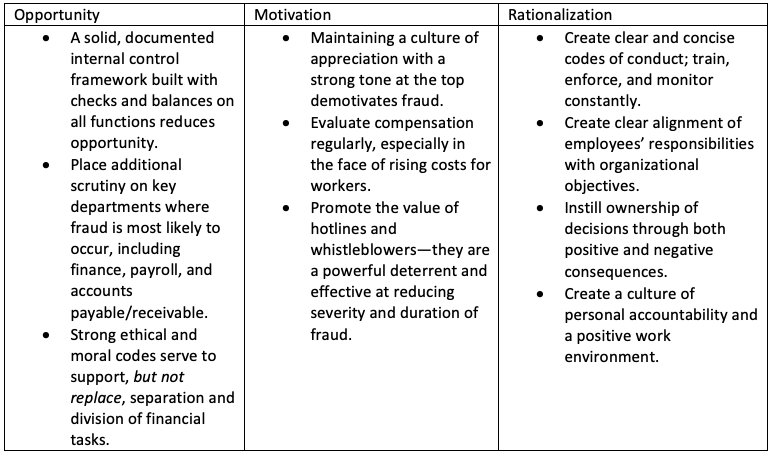In November 2021, a former church bookkeeper was sentenced to five and a half years in federal prison. She pleaded guilty to two counts of bank fraud in connection with her embezzlement of over $450,000. As the church bookkeeper, she had access to the church’s general ledger and bank statements. She was able to conceal the fraud for nearly six years.
Victims of dishonest employees are often surprised to hear that their stories are very similar to others: A trusted, long-term employee with a sterling background shockingly betrays the organization’s trust and uses the organization’s money for their own self-interest.
Theft and embezzlement by employees are not aberrations, but an unfortunate reality. They can occur at organizations of any size and type, from the smallest charity to the largest multinational company. By understanding the circumstances under which fraud takes hold, you can help your organization be better prepared to spot and prevent fraud in the future.
In this article, we’ll look at the specific circumstances that contribute to fraud as well as the myths surrounding financial crime. We will end with some guidelines that can help you prevent fraud.
The Fraud Triangle: Three Legs to a Stool
Embezzlement is a calculated crime that flourishes under specific circumstances. There are three legs to the proverbial stool on which fraud sits:
1) an opportunity to take advantage of a situation
2) a motivating factor, such as incentive or pressure on the individual
3) a rationalization the person uses to justify the fraud as acceptable.
The removal of one or more of these elements reduces the likelihood of fraud occurring within an organization.
To better understand why “good people do bad things,” let’s first debunk some common myths about the causes of fraud within companies and organizations.
Myth #1: A clean background precludes fraud.
Fact: Most employees who commit fraud are first-time offenders and have no criminal record. Only 6% of perpetrators had a prior fraud conviction. Because most employees begin their scheme once employed, initial background checks and vetting may be less effective than you think.
Takeaway: While they are useful for all hires, background and credit checks are more effective if they are performed on employees who are in positions of authority and those who have access to the money or accounts of the company. These tools help the employer screen for financial pressures, such as high debt, overdue payments, and collections actions. These are potential incentives for the employee to take advantage of the organization and embezzle funds.
Myth #2: We can detect fraud when the auditors and management review the books and accounts.
Fact: Sadly, occupational fraud is rarely detected by traditional external auditors or management reviews. In fact, fraud is most commonly detected by tips (42% of the time), usually from other employees.
Takeaway: Employers cannot rely solely on formal audits and management reviews to detect embezzlement. It is often the very employees responsible for handling funds and accounts who commit fraud. These employees can abuse their position of power and steal money by exploiting a weakened control. For example, your organization is at higher risk for fraud if you allow the same employee to oversee reconciling bank statements while also handling deposits or making payments for the company.
Creating an environment that encourages people to report concerns and tips via a hotline can help spot fraud and stop it in its tracks. On average, organizations with tip hotlines have half the amount of fraud losses as those without hotlines. In addition, hotlines allow organizations to detect fraud more quickly.
Myth #3: If we empower our employees and trust them, they will always execute their duties faithfully.
Fact: Opportunity to steal usually presents as a flaw or weakness in internal controls. Too much trust in one person can be a serious concern. For example, allowing an employee to control an entire process (such as approving suppliers as well as paying their invoices) creates the conditions for an employee to commit dishonest acts.
Takeaway: Trust is critical to a healthy employer-employee relationship, but too much trust—without effective checks and balances—puts too much opportunity in the hands of the employee.
Keys to Prevention
It’s important to remain vigilant to stop these activities from sabotaging your organization. Fortunately, there is hope for the organization that lowers the risk of dishonesty from within its ranks. By focusing on the three legs of the stool—opportunity, motivation, and rationalization—organizations can make it more difficult for fraud to find a seat at the table.

References:
- https://www.justice.gov/usao-ndtx/pr/church-employee-sentenced-5-years-embezzlement accessed January 30, 2023
- The author is indebted to the work of criminologist Donald R. Cressey and his seminal writings that document the “fraud triangle” (Other People’s Money: A Study in the Social Psychology of Embezzlement, Patterson Smith reprint series, 1973).
- https://legacy.acfe.com/report-to-the-nations/2022/


